MONDAY'S SCRIPT TIP:
BLAND HEROES
X MEN APOCALYPSE was a just okay sequel to FIRST CLASS - my favorite in the series with it's origins story mixed with the always cool idea of the
(fictional mutant) history behind an actual historical event. Though conspiracy theories in real life are
usually the result of paranoia and mental illness, in fiction they are one of my favorite types of story, from
PARALLAX VIEW to THEY LIVE. FIRST CLASS had elements of the Cold War *secretly* caused by the secret mutant wars
that the government didn't want you to know about. The film before that, FUTURES PAST seemed to connect those 1960s versions of the
characters with their present day versions through time travel. All of these films could use the help of the Marvel Machine, which seems to focus on character and story as well as spandex.

Yeah, you're thinking: just another superthero sequel!
The reason why they make so many sequels in Hollywood? The original film was successful.
and they believe the audience is ready for a second helping... or third... or fourth... or fifth!
They made (the not so good) X-MEN 3 because X2: X-MEN UNITED made $85.9 million
here in the US and $69.3 in other countries for a total of $155.2
million on its OPENING WEEKEND... then continued to do well for about a month in the summer.
The last movie in the series, LOGAN, only made $226 million in the USA and $393 million in the rest of the world for a worldwide total of over $619 million... and even some Oscar buzz!
The two DEADPOOL movies are kind of on the side of the X-MEN series, and have made a bundle of money - the last one made $734 million worldwide, and is being rereleased on December 21st with some new footage.
If you haven't seen last year's LOGAN, check it out!
But we're not talking about box office grosses, here, we're talking about *characters*... and how to create an
interesting character...
I loved Nightcrawler in X-MEN 2! From the water-color wisps of blue
when he teleports to his deeply religious beliefs (can you think of any other superhero
who prays before battle?) to his prattling on about his great moments as a circus
performer whenever he introduces himself to somebody. And that tail! Amazing how he
whips it around, grabs a knife, and hands it to himself (or should that be "tails it to
himself"?). Nightcrawler was so weird and fun that you just want to whole film to be
about him!

Which might have been a problem, because Nightcrawler is only a minor character in the film.
He's not the lead, but he's the most interesting guy on screen. This isn't a major
problem because X-MEN UNITED is an ensemble story with a bunch of protagonists -
so many that at times it seems like a super hero soap opera! More characters means
less time with each - and that translates to short-handing conflict so that it often seems
corny. Without the time to dig deep into the conflict, we only get the surface - the love
triangles and entanglements without the deeper emotions. I have no iddea why superhero movies want to
add more villains and more subplots... except maybe to pad the story. Always better to go *deeper*
into character and story than to go *wider* with more characters and more story. Even if you are
dealing with mutants. Find the spine of the story and deal with the characters who are part of that spine,
not characters on the periphery.
The closest thing we have to
a protagonist in X-MEN UNITED is Wolverine... and he's a pretty interesting character. Of course, he has a
metal skeleton, can heal in seconds, and has razor sharp claws. Hard not to notice a
guy like that. He's not the least bit bland... which is why he's the successful spinoff character. Sure,
some of that may have to do with Hugh Jackman always being shirtless (which means guys who like X MEN
movies can probably find a date to see the film with), but mostly because this is a character with a
strong conflict raging inside of them. A character we can care about due to their flaws.
In many scripts (where the lead doesn't have metal claws), the protagonist can be
completely over-shadowed by the supporting characters. These folks who are only
onscreen for a couple of minutes steal the show like Nightcrawler. Since they don't
have much screen time, we tend to make every second count for them... and we're also
free to exaggerate their personalities. Next thing you know, the reader remembers that
great hotel clerk in your script but can't recall your lead's name. What can we do to
make sure our leads stay in the lead?
STRENGTHEN CHARACTER

Think of the movie AIRPLANE - Lloyd Bridges is just way out there ("Looks like I picked
the wrong day to quit sniffing glue!") and makes an instant impression. But that doesn't
prevent Robert Hayes from having a character and a bunch of funny bits (his drinking
problem). The difference is - Bridges is concentrated, Hayes' character is spread out
over the entire film... and his drinking problem is connected to his character arc (fear
and guilt about being a pilot in the war, and George Zipp's death) which is connected to
the plot conflict (they are on a plane that needs a pilot!).
The problem may be that you have colorful supporting characters and a bland lead.
Make sure your lead has some color. If that means taking some of the sidekick's funny
lines and re-assigning them to the lead, that's what you have to do. I've done that
before many times. Nightcrawler is a funny character, but Wolverine isn't exactly a
wallflower. Some of the funniest lines in the film come from Wolverine! He's not just the
lead, he's also a fun character. You want your protagonist to have all of the best lines!
What is Wolverine a professor of? When we get Wolverine and Nightcrawler in the
same scene (on the plane) both are strong characters. Wolverine doesn't fall into the
shadow of Nightcrawler - he's got zinger after zinger and ends up getting the last word
in the conversation. Make sure your protagonist gets the good lines! A star is going to
play that role, and they aren't going to want some day player to steal the movie from
them. Just because *we* may be shy or introverted as writers is no reason to make your characters
shy or introverted. Make them *interesting*.
STRENGTHEN EMOTIONS

Also make sure that your lead HAS a character - that he has some emotional struggle
that we become involved with. Sometimes the big problem with a bland protagonist is
that they are not involved in the conflict or that the conflict doesn't hit them on an
emotional level... or that the reader is never put in the lead's shoes so we never
EXPERIENCE what the protagonist experiences.
One reason why we shy away from creating emotional conflicts for our protagonists is
that they are (secretly) us - so we are dealing with OUR emotional conflicts. So what do
YOU fear? It's your story, your protagonist... so use your fears. Find an EMOTIONAL
fear (rather than a fear of something physical) that fits the theme of your story.
I'd start with your concept and do a little self-analysis - why did that concept grab you?
What fear of yours does it explore? That the system you believe in is wrong - and you
are part of that wrong? That everything you have fought for is meaningless? Maybe you
fear betraying your family (the system)?
You're searching for YOUR emotional fear... and that's going to be painful. But that's
the kind of pain that makes your protagonist real, emotional, and strikes a chord with
the audience. That fear is where you're going to find the theme - that fear is what the
script is really about - that fear is going to dictate what happens in the script... every
scene is going to explore your theme in some way (which is the protagonist battling
their emotional fear). Fear is the key. If your protagonist doesn't have any emotional conflict
they are just a cardboard cut out solving a problem. If you look at Wolverine in X2, he's a guy
who can't remember his past. Doesn't know how he got to be the way he is. He's searching for
the past... but he's afraid of what he'll find. He's afraid that he's really a monster. He's not the
most social person in the world - always leaving, hiding, hunting. When he finally meets Stryker
- his father in a strange way - he learns the truth... and it's not what he wants to hear. He's just an
animal. A creature designed to kill. Everything he has feared is true!

It's Wolverine's fears about himself that make him an interesting character. He's not just a bland
good guy - he's tortured. He's brooding. He's on a quest to discover his past - and scared of what
he will find. If you look at all of the X-MEN characters, you'll find that fears define them. The
bigger the fear, the more interesting the character. Compare Rogue to Storm. Rogue is more
interesting because she fears hurting those that she loves... Storm just has cool powers. Rogue is
like a sponge: everyone she touches; she removes their memories, their physical strength... and their
life. They die an empty shell. Nice story if it ends there, but Rogue is also a young woman who is in
love with a boy named David... and when she kisses him? Like Wolverine, everyone she touches dies.
She is a young woman looking for love... but knowing that she can never love. One of
the reasons why Nightcrawler is interesting is because he's deeply religious - and filled with guilt
(and probably self-loathing). The emotional conflict, that fear, is what makes the characters
interesting. Make sure your protagonist isn't just surface... give them an emotional conflict that
will make them interesting and three dimensional.
THE WAR WITHIN

THE WOLVERINE (2013) is an introspective meditation on mortality, disguised as a superhero movie...
and one of the first scenes shows the protagonist's emotional conflict. He wakes up in bed with the
love of his life Jean Gray (who has died, so we know this is a dream) and she wants to embrace him,
make love with him... but he tries to hold her back. When he gives in to his emotions and embraces her...
his metal claws pierce her flesh and kill her. He has killed the woman he loves... the way he kills
anything he loves. When he wakes up from this nightmare he is alone in some rugged Canadian Yukon cabin,
having isolated himself from society so that he can never hurt anyone again. He is an immortal man
whose life is a filled with regret and pain that he has caused... and there will never be any escape.
It sounds cool to be a mutant whose body heals itself *no matter what happens to it*, but in the end
you just experience tragedy after tragedy with no release. Your life is torture without the possibility
of death. You will witness everyone you love's death... and it's likely that you may be responsible for
that death... and have to live with that knowledge *forever*. Okay, folks, *that's* a conflicted character.
That's someone who is not a pencil sketch, but a fully fleshed out person... and that's in a stupid
superhero movie.

Look for the conflict simmering inside the character... that thing that is about to explode into
external conflict. In the Protagonist Blue Book I have a chapter called Pulp Friction about the raging war
within great protagonists, and that chapter title comes from the hitmen in PULP FICTION who are looking
for peace and redemption... but are *violent killers*. How can someone be both? They are at odds with
themselves! Their nature is at war with their goals, and they become fascinating characters due to this.
They have conflicting goals. The way to make your protagonist memorable is to dig deep behind the surface
and find that conflict within... that thing that makes them dimensional. The thing that makes sure when
Wolverine and Nightcrawler are in scenes together, we still focus on Wolverine because we worry about
that dude.
THE WOLVERINE doesn't just stop at that early scene, it explores this war within the protagonist in
scene after scene... because the story selected *forces* Wolverine to confront these things. Back in
World War 2 he was a prisoner in Nagasaki when the atom bomb was dropped, and he risked his life to save
the only Japanese soldier who was kind to him. Decades later, Wolverine looks exactly the same... but
that young Japanese guard is now a dying old Japanese billionaire who offers him a chance for mortality.
A genetic swap so that the billionaire can live and Wolverine can be released from his pain and die.
See how the story turns Wolverine's emotional problems to the surface? Turns the internal into the external
(something we can see on screen)? Again and again Wolverine will be faced with choices that he must act
upon that cut right to that war raging within himself. That conflict between a man who wants to be released
from his pain... but also wants the joy of love and life that has eluded him. And yes, this is still a
superhero movie.
And LOGAN was even better - a modern day western that looked at aging and mortality.
Your Screenplay Checklist:
1) Give your lead character an emotional conflict - something that creates dramatic scenes.
2) Make sure that emotional conflict is a conflict: that they have conflicting goals and a war raging within.
3) Create the story which brings that emotional conflict to the surface in a series of difficult decisions.
4) Don't give all of the good lines and good character bits to the smaller roles - the star role needs to shine!
5) Make sure the conflict is *about* the protagonist, that he or she is not just a bystander in the story.
You want to make sure your protagonist is the most interesting character in the script - not some
waiter who only appears in Scene 73!
If you liked this Script Tip, you'll like the Protagonist Blue Book!
BRAND NEW!
How Do I do That?

101 SCREENWRITING ANSWERS Blue Book!
New to screenwriting? You probably have questions! How do I get an Agent? How do I write a phone conversation? Do I need a Mentor? What’s does VO and OC and OS mean? What is proper screenplay format? Should I use a pen name? Do I need to movie to Hollywood? What’s the difference between a Producer and a Production Manager, and which should I sell my script to? How do I write a Text Message? Should I Copyright or WGA register my script? Can I Direct or Star? How do I write an Improvised scene? Overcoming Writer’s Block? How do I write a Sex Scene? And many many more! This book has the answers to the 101 Most Asked Questions from new screenwriters! Everything you need to know to begin writing your screenplay!
All of the answers you need to know, from a working professional screenwriter with 20 produced films and a new movie made for a major streaming service in 2023!
Only $4.99
NEWEST AND BLUEST!
Want To Look Like An Expert?

RESEARCH & WORLD BUILDING Blue Book!
Does this gun fire 6 shots or only 5? In all of the excitement of writing your action scene, you might not have done the research... and your hero could be out of ammo! Whether you are writing a novel or screenplay, you can save your hero, and your story, by doing a little research first! This book looks at Why you should research, Whether you should research First or Later, PLUS the importance of World Building in Science Fiction, Fantasy... and the worlds you explore in every other genre. Movies like JOHN WICK and THE GODFATHER take place in their own unique worlds... and writers must create them! YOU are the technical advisor on your Screenplay or Novel.
Using movie examples like TOP GUN, HUNT FOR RED OCTOBER, BLUE CRUSH, ADVENTURE LAND, several of my produced films, JOHN WICK, the novels of Donald E. Westlake and Thomas B. Dewey, SPY KIDS, the LORD OF THE RINGS movies, SOYLENT GREEN (which takes place in the far off future of 2022), and many others we will look at researching stories and creating worlds. The 8 Types Of Research, the 10 Types Of Information To Look For, 12 Important Elements Of World Building. Plus chapters on How To Rob A Bank and Commit Murder And Get Away With It for those of you interested in crime fiction, and Researching The Future for those writing science fiction, and Levels Of Reality if you are writing about a version of the real world.
No matter what you are writing, this book will help you find the facts... or make them up in a convincing way!
Only $4.99
NO KINDLE REQUIRED! Get the *free* app (any device, except your Mr. Coffee) on the order page on Amazon!
FINISHED WRITING?
All About Rewrites!
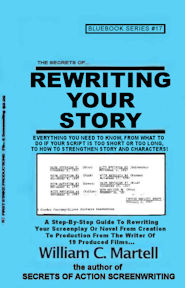
REWRITES Blue Book!
Rewriting In Waves?
When You Finish Your Screenplay Or Novel...
The Rewrites Begin!
The end is just the beginning! You’ve finished your story, but now the rewriting begins! This 405 page book shows you how to rewrite your screenplay or novel to perfection. Everything from Character Consistency to Shoeboxing to How To Give And Receive Notes to 15 Solutions If Your Script’s Too Long! and 15 Solutions If Your Script’s Too Short! to Finding The Cause Of A Story Problem to Good Notes Vs. Bad Notes to Finding Beta Readers to Avoiding Predictability to Learning To Be Objective About Your Work to Script Killer Notes and Notes From Idiots to Production Rewrites and What The Page Colors Mean? and a Complete Rewrite Checklist! The complete book on Rewriting Your Story!
Only $4.99
NEW ISH!
All About Endings!
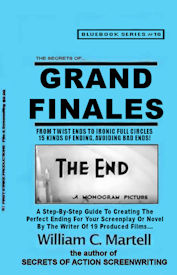
GRAND FINALES Blue Book!
The Perfect Ending For Your Story!
The First Ten Pages Of Your Screenplay Are Critical,
But What About The Last 10 Pages?
Creating the perfect ending to your story! This 100,000 word book shows you how to end your story with a bang, rather than a whimper. Everything from Resolution Order to Act Three Tools to Happy or Sad Endings? to How The Beginning Of Your Story Has Clues To The Ending (in case you were having trouble figuring out how the story should end) to Falling Action to How To Avoid Bad Endings to Writing The Perfect Twist Ending to Setting Up Sequels & Series to Emotional Resolutions to How To Write Post Credit Sequences to Avoiding Deus Ex Machinas, to 20 Different Types Of Ends (and how to write them) and much more! Everything about endings for your screenplay or novel!
Only: $4.99
NO KINDLE REQUIRED! Get the *free* app (any device, except your Mr. Coffee) on the order page on Amazon!
SHRINKING IT DOWN
All About LOGLINES, TREATMENTS, and PITCHING!

LOGLINES, TREATMENTS, and PITCHING! Blue Book!
Distilling Your Screenplay!
Loglines, Treatments, Pitching, Look Books, Pitch Decks, One Pagers, Rip-O-Matics?
You have written a brilliant 110 page screenplay, but how do you get anyone to read it? You need to distill it down into some form of verbal moonshine or story rocket fuel that will ignite that bored development executive or manager or agent and get them to request your screenplay. But how do you shrink those 110 pages into a 25 word logline or a 2 minute elevator pitch or a one page synopsis or a short paragraph? This 100,000 word book shows you how! Everything you need to know! From common logline mistakes (and how to solve them) to how your pitch can reveal story problems to the 4 types of pitches!
272 Pages - ONLY $4.99!
NEW in 2020!
Making Your Own Movie?
WRITE IT: FILM IT BOOK!

Making Your Own Movie?
Writing An Indie Film?
Writing A Low Budget Genre Script To Sell?
Writing A Made For TV Holiday Movie?
You will be writing for BUDGET. On a standard spec screenplay, you don’t have to think about budget, but these types of screenplays writing with budget in mind is critical!
If you are making your own movie, budget, is even more important - and you need to think about budget *before* you write your screenplay... or you will end up with a script that you can’t afford to make (or is a struggle to make). Everyone is making their own films these days, and even if you have done it before there are lots of great techniques in this book to get more money on screen - for less money! You can make a film that looks like it cost millions for pocket change.
344 Pages - ONLY: $7.99!
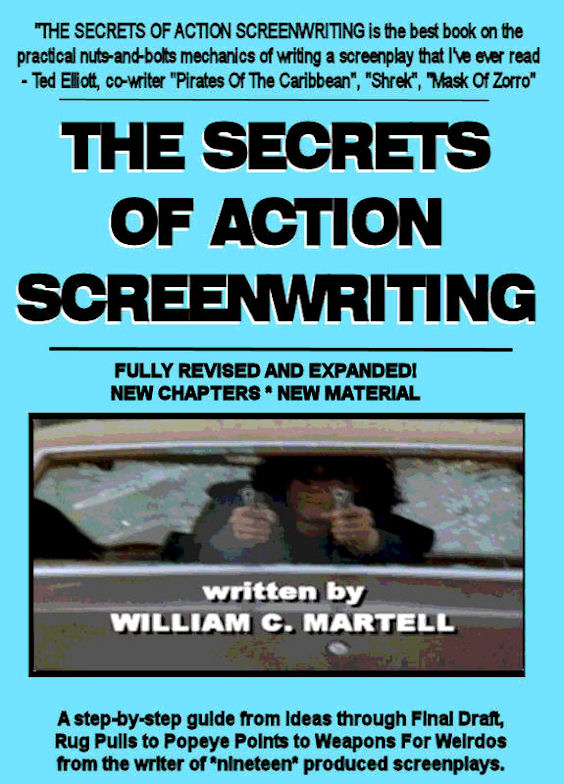
THE BOOK THAT STARTED IT ALL!
*** THE SECRETS OF ACTION SCREENWRITING *** - For Kindle!
*** THE SECRETS OF ACTION SCREENWRITING *** - For Nook!
Why pay $510 for a used version of the 240 page 2000 version that used to retail for $21.95? (check it out!) when
you can get the NEW EXPANDED VERSION - over 500 pages - for just $9.99? New chapters, New examples, New techniques!
"SECRETS OF ACTION SCREENWRITING is the
best book on the practical nuts-and-bolts mechanics of writing a screenplay I've ever read."
- Ted Elliott, co-writer of MASK OF ZORRO, SHREK, PIRATES OF THE CARIBBEAN and the sequels (with Terry Rossio). (ie; 4 of the top 20 Box Office Hits Of ALL TIME.)
Only $9.99 - and no postage!
BRAND NEW!
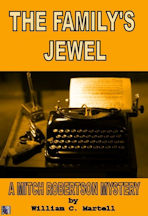
***
MITCH ROBERTSON #2: THE FAMILY'S JEWEL *** - For Kindle!
"The Presidential Suite of the Hollywood Hoover Hotel looked like a bloody battlefield: bodies everywhere, furniture broken, red liquid dripping from the walls, dead soldiers littering the elegant Berber rug as clouds of smoke overhead bounced between two air conditioning vents.
Mitch Robertson stepped over the body of an ex-child star turned sex tape star turned pop star and entered the room, spotted a gun on the floor and picked it up... careful not to spill his coffee with three pumps of mocha syrup from Penny’s Coffee Shop. That coffee was gold, the only thing keeping him going in this dazed state of wakefulness. The gun felt light. Holding it, he saw the silhouette of an 80s action star sitting sideways on a tipped over chair. Motionless. Was he dead? Mitch was still hung over from the Awards Party the night before, and wondered whether this was all some sort of crazy nightmare that he would wake up from... but when he tripped over the brown legs of a bottomless Superhero, flaccid junk encased in a condom but still wearing his mask, and hit the edge of the sofa, gun skittering and coffee spilling, he realized that it was all very real. What the hell had happened here?"
Short Novel. Only 99 cents! - and no postage!
Tips FAQ

My New Script Secrets Newsletter!

THE BLUE BOOKS!
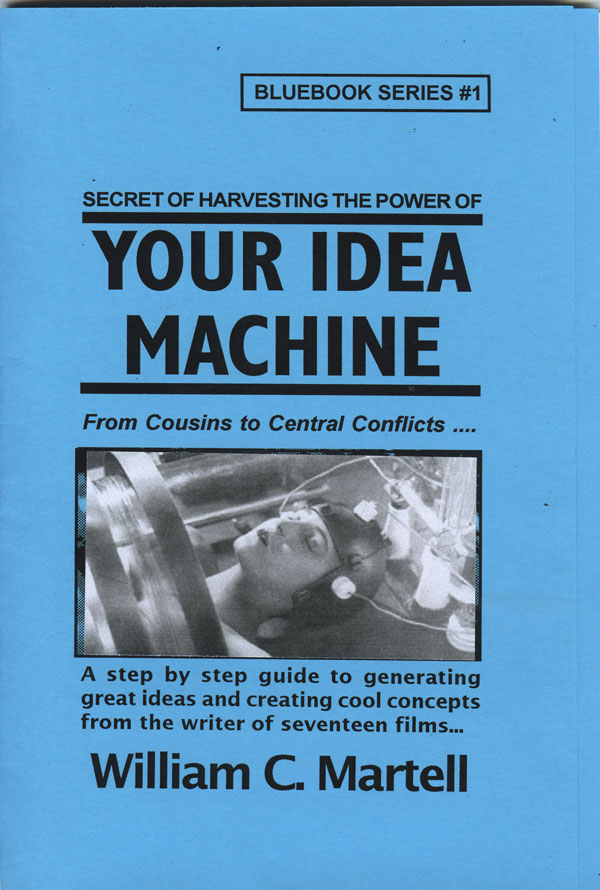
FIND A GREAT IDEA!
*** YOUR IDEA MACHINE *** - For Kindle!
****
Expanded version with more ways to find great ideas! Your screenplay is going to begin with an idea. There are good ideas and bad ideas and commercial ideas and personal ideas. But where do you find ideas in the first place? This handbook explores different methods for finding or generating ideas, and combining those ideas into concepts that sell. The Idea Bank, Fifteen Places To Find Ideas, Good Ideas And Bad Ideas, Ideas From Locations And Elements, Keeping Track Of Your Ideas, Idea Theft - What Can You Do? Weird Ways To Connect Ideas, Combing Ideas To Create Concepts, High Concepts - What Are They? Creating The Killer Concept, Substitution - Lion Tamers & Hitmen, Creating Blockbuster Concepts, Magnification And The Matrix, Conflict Within Concept, Concepts With Visual Conflict, Avoiding Episodic Concepts, much more! Print version is 48 pages, Kindle version is over 175 pages!
Only $4.99 - and no postage!
FIGURE OUT YOUR STORY!
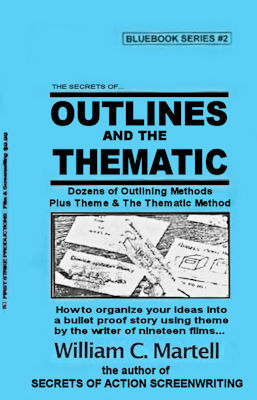
OUTLINES & THE THEMATIC Blue Book.
ARE YOUR SCENES IN THE RIGHT ORDER?
AND ARE THEY THE RIGHT SCENES?
Your story is like a road trip... but where are you going? What's the best route to get there? What are the best sights to see along the way? Just as you plan a vacation instead of just jump in the car and start driving, it's a good idea to plan your story. An artist does sketches before breaking out the oils, so why shouldn't a writer do the same? This Blue Book looks at various outlining methods used by professional screenwriters like Wesley Strick, Paul Schrader, John August, and others... as well as a guest chapter on novel outlines. Plus a whole section on the Thematic Method of generating scenes and characters and other elements that will be part of your outline. The three stages of writing are: Pre-writing, Writing, and Rewriting... this book looks at that first stage and how to use it to improve your screenplays and novels.
Only $4.99 - and no postage!
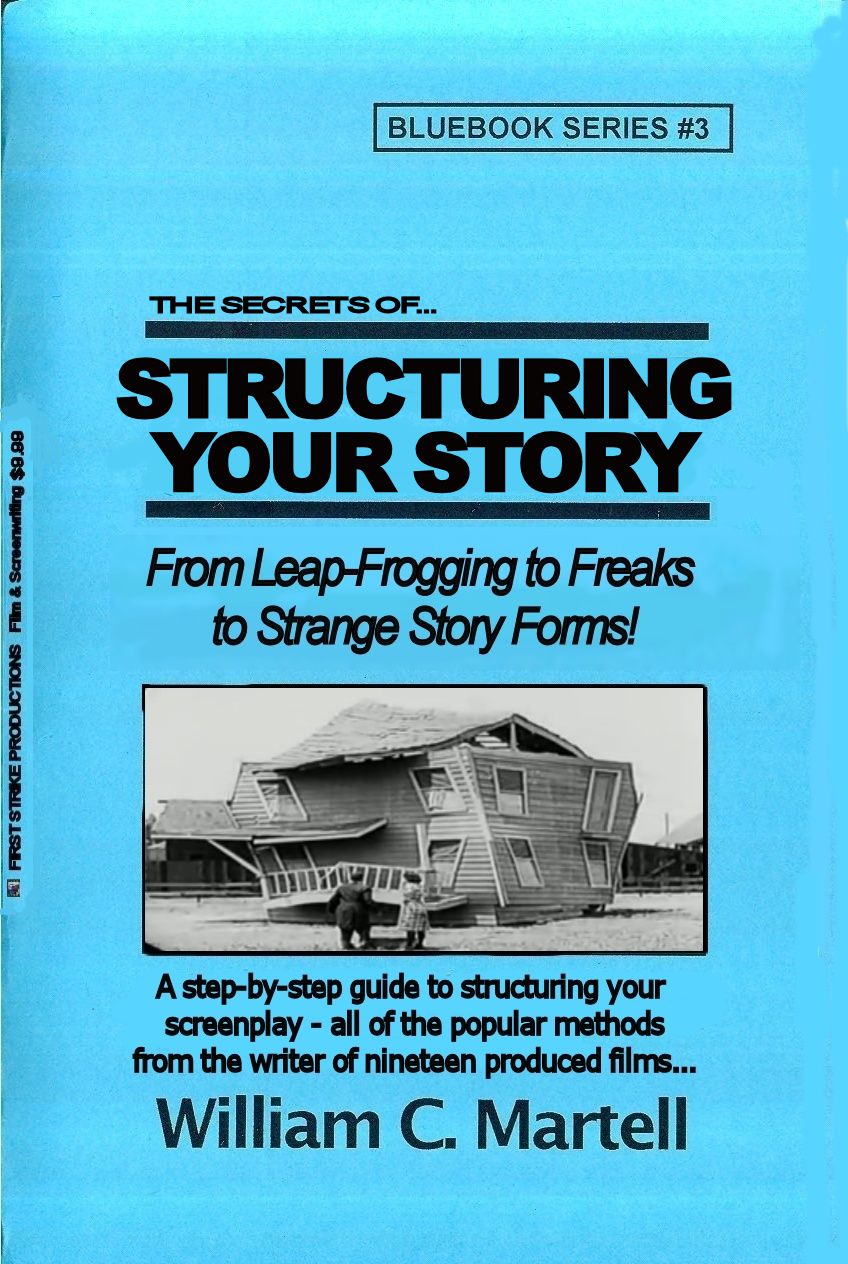
GOT STRUCTURE?!
*** STRUCTURING YOUR STORY *** - For Kindle!
William Goldman says the most important single element of any screenplay is structure. It’s the skeleton under the flesh and blood of your story. Without it, you have a spineless, formless, mess... a slug! How do you make sure your structure is strong enough to support your story? How do you prevent your story from becoming a slug? This Blue Book explores different types of popular structures from the basic three act structure to more obscure methods like leap-frogging. We also look at structure as a verb as well as a noun, and techniques for structuring your story for maximum emotional impact. Most of the other books just look at *structure* and ignore the art of *structuring* your story. Techniques to make your story a page turner... instead of a slug!
Only $4.99 - and no postage!

STORY: WELL TOLD!
*** STORY: WELL TOLD *** - For Kindle!
This book takes you step-by-step through the construction of a story... and how to tell a story well, why Story always starts with character... but ISN'T character, Breaking Your Story, Irony, Planting Information, Evolving Story, Leaving No Dramatic Stone Unturned, The Three Greek Unities, The Importance Of Stakes, The Thematic Method, and how to create personal stories with blockbuster potential. Ready to tell a story?
Print version was 48 pages, Kindle version is over 85,000 words - 251 pages!
Only $4.99 - and no postage!

START STRONG!
*** HOOK 'EM IN TEN *** - For Kindle!
Your story doesn't get a second chance to make a great first impression, and this book shows you a
bunch of techniques on how to do that. From the 12 Basic Ways To Begin Your Story, to the 3 Stars Of
Your First Scene (at least one must be present) to World Building, Title Crawls, Backstory, Starting
Late, Teasers and Pre Title Sequences, Establishing Theme & Motifs (using GODFATHER PART 2), Five Critical
Elements, Setting Up The Rest Of The Story (with GODFATHER), and much more! With hundreds of examples
ranging from Oscar winners to classic films like CASABLANCA to some of my produced films (because
I know exactly why I wrote the scripts that way). Biggest Blue Book yet!
Print version was 48 pages, Kindle version is over 100,000 words - 312 pages!
Only $4.99 - and no postage!
NO KINDLE REQUIRED! Get the *free* app (any device, except your Mr. Coffee) on the order page on Amazon!
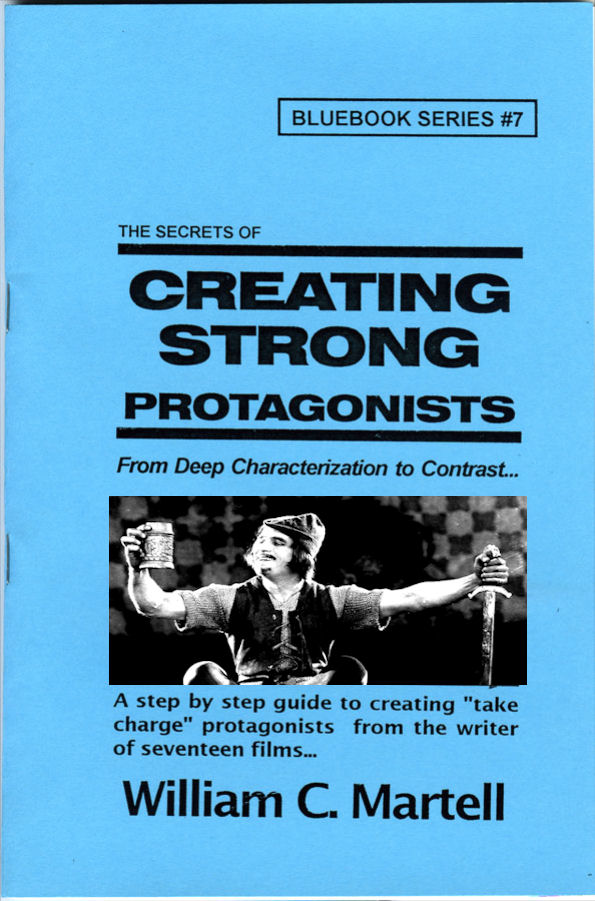
MOVIES ARE CHARACTERS!
*** CREATING STRONG PROTAGONISTS *** - For Kindle!
*** CREATING STRONG PROTAGONISTS *** - For Nook!
Expanded version with more ways to create interesting protagonists! A step-by-step guide to creating "take charge" protagonists. Screenplays are about characters in conflict... characters in emotional turmoil... Strong three dimensional protagonists who can find solutions to their problems in 110 pages. But how do you create characters like this? How do you turn words into flesh and blood? Character issues, Knowing Who Is The Boss, Tapping into YOUR fears, The Naked Character, Pulp Friction, Man With A Plan, Character Arcs, Avoiding Cliche People, Deep Characterization, Problem Protagonists, 12 Ways To Create Likable Protagonists (even if they are criminals), Active vs. Reactive, The Third Dimension In Character, Relationships, Ensemble Scripts, and much, much more. Print version is 48 pages, Kindle version is once again around 205 pages!
ONLY $4.99 - and no postage!
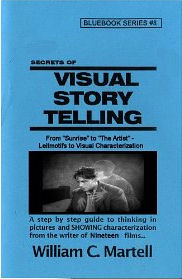
I WRITE PICTURES!
*** VISUAL STORYTELLING *** - For Kindle! (exclusive)
Show Don't Tell - but *how* do you do that? Here are techniques to tell stories visually! Using Oscar Winning Films and Oscar Nominated Films as our primary examples: from the first Best Picture Winner "Sunrise" (1927) to the Oscar Nominated "The Artist" (which takes place in 1927) with stops along the way Pixar's "Up" and Best Original Screenplay Winner "Breaking Away" (a small indie style drama - told visually) as well as "Witness" and other Oscar Winners as examples... plus RISE OF THE PLANET OF THE APES. Print version is 48 pages, Kindle version is over 200 pages!
ONLY $4.99 - and no postage!
DESCRIPTION & VOICE Blue Book!
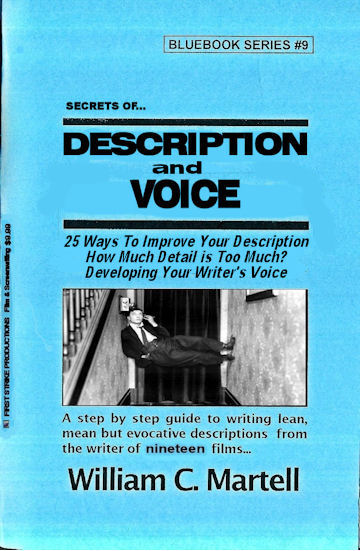
DESCRIPTION & VOICE Blue Book.
IS HALF OF YOUR STORY IN TROUBLE?
Most screenplays are about a 50/50 split between dialogue and description - which means your description is just as important as your dialogue. It just gets less press because the audience never sees it, the same reason why screenwriters get less press than movie stars. But your story will never get to the audience until readers and development executives read your script... so it is a very important factor. Until the movie is made the screenplay is the movie and must be just as exciting as the movie. So how do you make your screenplay exciting to read? Description is important in a novel as well, and the “audience” does read it... how do we write riveting description?
Only $4.99 and no postage!

PRO DIALOGUE TECHNIQUES!
*** DIALOGUE SECRETS *** - For Kindle!
***
Expanded version with more ways to create interesting dialogue! How to remove bad dialogue (and what *is* bad dialogue), First Hand Dialogue, Awful Exposition, Realism, 50 Professional Dialogue Techniques you can use *today*, Subtext, Subtitles, Humor, Sizzling Banter, *Anti-Dialogue*, Speeches, and more. Tools you can use to make your dialogue sizzle! Special sections that use dialogue examples from movies as diverse as "Bringing Up Baby", "Psycho", "Double Indemnity", "Notorious", the Oscar nominated "You Can Count On Me", "His Girl Friday", and many more! Print version is 48 pages, Kindle version is over 175 pages!
Only $4.99 - and no postage!

WHAT IS A SCENE?
*** SCENE SECRETS *** - For Kindle!
***
What is a scene and how many you will need? The difference between scenes and sluglines. Put your scenes on trial for their lives! Using "Jaws" we'll look at beats within a scene. Scene DNA. Creating set pieces and high concept scenes. A famous director talks about creating memorable scenes. 12 ways to create new scenes. Creating unexpected scenes. Use dramatic tension to supercharge your scenes. Plants and payoffs in scenes. Plus transitions and buttons and the all important "flow"... and more! Over 65,000 words! Print version was 48 pages, Kindle version is around 210 pages!
Only $4.99 - and no postage!
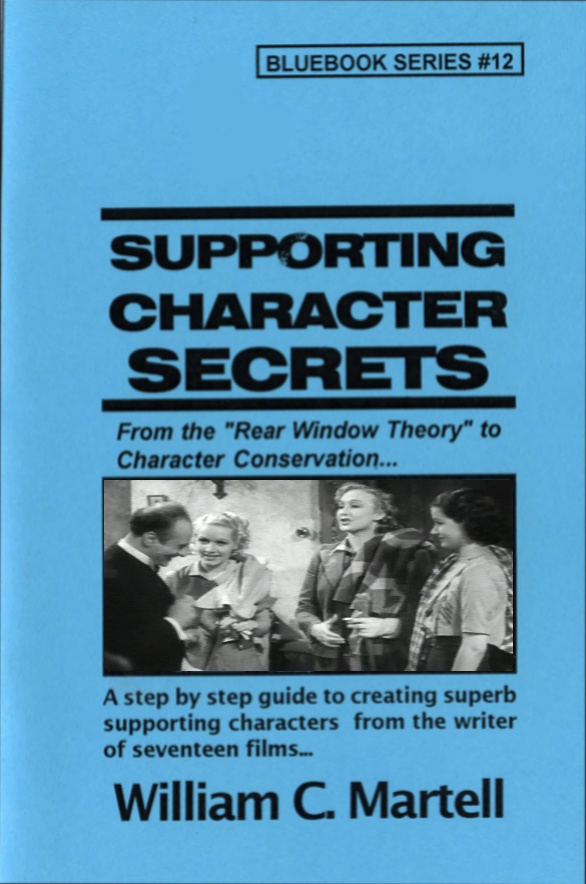
SUBPLOTS?
*** SUPPORTING CHARACTER SECRETS *** - For Kindle! (Exclusive)
Expanded version with more techniques to flesh out your Supporting Characters and make them individuals. Using the hit movie BRIDESMAIDS as well as other comedies like THE HANGOVER and TED and HIGH FIDELITY and
40 YEAR OLD VIRGIN and many other examples we look at ways to make your Supporting Characters come alive on the page.
Print version was 48 pages, Kindle version is around 170 pages!
ONLY $4.99 - and no postage!
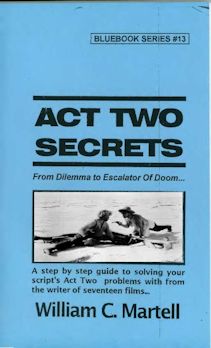
ACT TWO SOLUTIONS!
*** ACT TWO SECRETS *** - For Kindle!
Expanded version with more techniques to help you through the desert of Act Two! Subjects Include: What Is Act Two? Inside Moves, The 2 Ps: Purpose & Pacing, The 4Ds: Dilemma, Denial, Drama and Decision, Momentum, the Two Act Twos, Subplot Prisms, Deadlines, Drive, Levels Of Conflict, Escalation, When Act Two Begins and When Act Two Ends, Scene Order, Bite Sized Pieces, Common Act Two Issues, Plot Devices For Act Two, and dozens of others. Over 67,000 words (that’s well over 200 pages) of tools and techniques to get you through the desert of Act Two alive!
Print version was 48 pages, Kindle version is well over 200 pages!
ONLY $4.99 - and no postage!
READY TO BREAK IN?
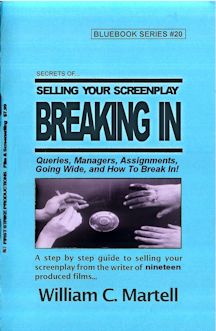
THE BUISINESS SIDE
*** BREAKING IN BLUE BOOK *** - For Kindle!
Should really be called the BUSINESS BLUE BOOK because it covers almost everything you will need to
know for your screenwriting career: from thinking like a producer and learning to speak their language,
to query letters and finding a manager or agent, to making connections (at home and in Hollywood) and
networking, to the different kinds of meetings you are will have at Studios, to the difference between
a producer and a studio, to landing an assignment at that meeting and what is required of you when you
are working under contract, to contracts and options and lawyers and... when to run from a deal!
Information you can use *now* to move your career forward! It's all here in the Biggest Blue Book yet!
Print version was 48 pages, Kindle version is over 400 pages!
$4.99 - and no postage!

STORY IN ACTION SERIES!

THE MISSION IMPOSSIBLE MOVIES
NEW: Updates On Films 7 & 8 Casting!
All Six Movies analyzed! All of the mission tapes, all of the “that’s impossible!” set pieces and stunts, the cons and capers - and how these scenes work, the twists and double crosses, the tension and suspense (and how to generate it), the concept of each film as a stand alone with a different director calling the shots (broken in the sixth film), the gadgets, the masks, the stories, the co-stars and team members (one team member has been in every film), the stunts Tom Cruise actually did (and the ones he didn’t), and so much more! Over 120,000 words of fun info!
THE MISSION IMPOSSIBLE MOVIES - 347 Pages - Only $3.99 !

BRAND NEW!
*** THE BOURNE MOVIES
NEW: Updates on TREADSTONE TV show!
All five "Bourne" movies (including "Legacy" and it's potential sequels) - what are the techniques used to keep the characters and scenes exciting and involving? Reinventing the thriller genre...
or following the "formula"? Five films - each with an interesting experiment! A detailed analysis of each
of the films, the way these thrillers work... as well as a complete list of box office and critical
statistics for each film. This book is great for writers, directors, and just fans of the series.
Only $3.99 - and no postage!
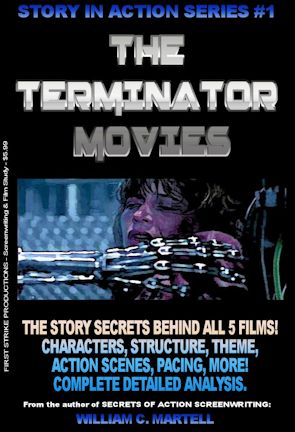
Over 240 pages!
*** THE TERMINATOR MOVIES *** - For Kindle!
He's back! The release of "Terminator: Dark Fate" is set to begin a new trilogy in
the Terminator story... 35 years after the first film was released. What draws us to these films about
a cybernetic organism from the future sent back in time? Why is there a new proposed trilogy every few
years? This book looks at all five Terminator movies from a story standpoint - what makes them work
(or not)? What are the techniques used to keep the characters and scenes exciting and involving? How
about those secret story details you may not have noticed? Containing a detailed analysis of each of
the five films so far, this book delves into the way these stories work... as well as a complete list of
box office and critical statistics for each film. This book is great for writers, directors, and just
fans of the series.
ONLY $3.99 - and no postage!
HITCHCOCK FOR WRITERS!
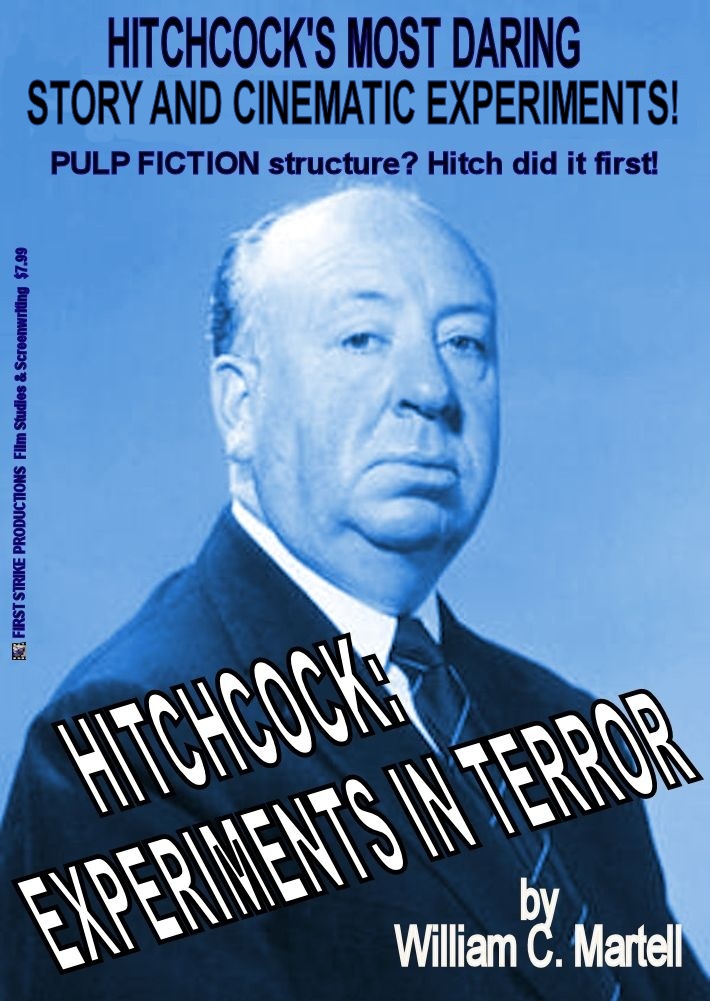
Strange Structures!
*** HITCHCOCK: EXPERIMENTS IN TERROR! *** - For Kindle!
***
Contained Thrillers like "Buried"? Serial Protagonists like "Place Beyond The Pines"? Multiple Connecting Stories like "Pulp Fiction"? Same Story Multiple Times like "Run, Lola, Run"?
HITCHCOCK DID IT FIRST!
This book focuses on 18 of Hitchcock's 52 films with wild cinema and story experiments which paved the way for modern films. Almost one hundred different experiments that you may think are recent cinema or story inventions... but some date back to Hitchcock's *silent* films! We'll examine these experiments and how they work. Great for film makers, screenwriters, film fans, producers and directors.
Only $5.99 - and no postage!
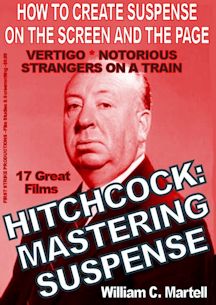
LEARN SUSPENSE FROM THE MASTER!
*** HITCHCOCK: MASTERING SUSPENSE *** - For Kindle!
Alfred Hitchcock, who directed 52 movies, was known as the *Master Of Suspense*; but what exactly is suspense and how can *we* master it? How does suspense work? How can *we* create “Hitchcockian” suspense scenes in our screenplays, novels, stories and films?
This book uses seventeen of Hitchcock’s films to show the difference between suspense and surprise, how to use “focus objects” to create suspense, the 20 iconic suspense scenes and situations, how plot twists work, using secrets for suspense, how to use Dread (the cousin of suspense) in horror stories, and dozens of other amazing storytelling lessons. From classics like “Strangers On A Train” and “The Birds” and “Vertigo” and “To Catch A Thief” to older films from the British period like “The 39 Steps” and “The Man Who Knew Too Much” to his hits from the silent era like “The Lodger” (about Jack The Ripper), we’ll look at all of the techniques to create suspense!
Only $5.99
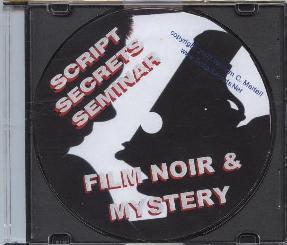
AUDIO CLASS!
NOIR & MYSTERY80 minute MP3 packed with information on writing Film Noir and Mystery scripts. Using examples from CHINATOWN to OUT OF THE PAST to DOUBLE INDEMNITY you'll learn how to create stories in this dark, twisted genre. How to plant clues, red herrings, suspects, victims, spider women, fallen heroes, the funhouse mirror world of noir supporting characters... and the origins of Film Noir in literature Noir dialogue and how noir endings are different than any other genre. All of the critical elements necessary to write in this critically popular genre.
The Noir & Mystery Class is only $15 (plus $5 S&H). First 20 on Limited Black Disk!
PAMDEMIC SALE! $5 OFF!
IDEAS AND CREATIVITY - 80 minute MP3 packed with information. Tools to find ideas that are both personal *and* commercial. Hollywood wants scripts with High Concept stories... but not stupid scripts. Developing *intelligent* high concept ideas. How to turn your personal story into a blockbuster - or find your personal story in a high concept idea. Brainstorming and being creative. Ideas and Creativity is $10.00 (plus $5 S&H)
WRITING INDIES - Writing an Indie film? This class covers everything you need to know - from Central Locations to Confined Cameos. Using examples from SWINGERS, THE COOLER, STATION AGENT and others, this 80 minute MP3 is packed with information. How Indoe films challenge the audience (while mainstream films reassure the audience). Structures, using BOYS DON'T CRY, RUN LOLA RUN, HILARY & JACKIE, and others as example. Writing for a budget, writing for non-actors, getting the most production value out of your budget. Writing Indies is $10.00 (plus $5 S&H)
WRITING HORROR - The essentials of a horror screenplay - what do ROSEMARY'S BABY, NIGHT OF THE LIVING DEAD, THE EXORCIST, BRIDE OF FRANKENSTEIN, THE OTHERS and OPEN WATER have in common? This class will tell you! All of the critical elements necessary to write a script that scares the pants off the audience. Writing Horror is $10.00 (plus $5 S&H).
Click here for more information on CLASS MP3s!

Use your creative energy to focus on the content; let Final Draft take care of the style. Final Draft is the number-one selling application specifically designed for writing movie scripts, television episodics and stage plays. Its ease-of-use and time-saving features have attracted writers for almost two decades positioning Final Draft as the Professional Screenwriters Choice. Final Draft power users include Academy, Emmy and BAFTA award winning writers like Oliver Stone, Tom Hanks, Alan Ball, J.J. Abrams, James Cameron and more.
* * * Buy It!

